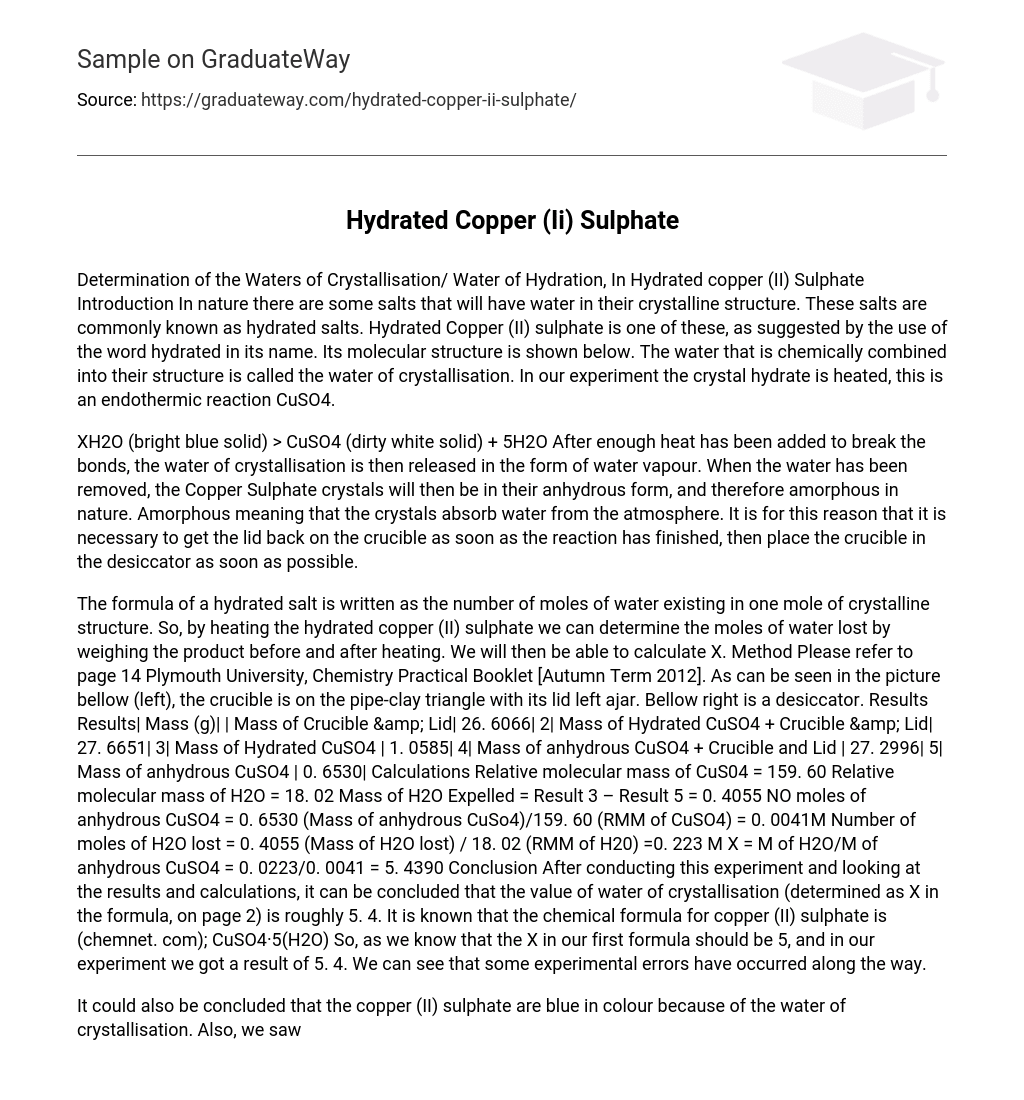Determination of the Waters of Crystallisation/ Water of Hydration, In Hydrated copper (II) Sulphate Introduction In nature there are some salts that will have water in their crystalline structure. These salts are commonly known as hydrated salts. Hydrated Copper (II) sulphate is one of these, as suggested by the use of the word hydrated in its name. Its molecular structure is shown below. The water that is chemically combined into their structure is called the water of crystallisation. In our experiment the crystal hydrate is heated, this is an endothermic reaction CuSO4.
XH2O (bright blue solid) > CuSO4 (dirty white solid) + 5H2O After enough heat has been added to break the bonds, the water of crystallisation is then released in the form of water vapour. When the water has been removed, the Copper Sulphate crystals will then be in their anhydrous form, and therefore amorphous in nature. Amorphous meaning that the crystals absorb water from the atmosphere. It is for this reason that it is necessary to get the lid back on the crucible as soon as the reaction has finished, then place the crucible in the desiccator as soon as possible.
The formula of a hydrated salt is written as the number of moles of water existing in one mole of crystalline structure. So, by heating the hydrated copper (II) sulphate we can determine the moles of water lost by weighing the product before and after heating. We will then be able to calculate X. Method Please refer to page 14 Plymouth University, Chemistry Practical Booklet [Autumn Term 2012]. As can be seen in the picture bellow (left), the crucible is on the pipe-clay triangle with its lid left ajar. Bellow right is a desiccator. Results Results| Mass (g)| | Mass of Crucible & Lid| 26. 6066| 2| Mass of Hydrated CuSO4 + Crucible & Lid| 27. 6651| 3| Mass of Hydrated CuSO4 | 1. 0585| 4| Mass of anhydrous CuSO4 + Crucible and Lid | 27. 2996| 5| Mass of anhydrous CuSO4 | 0. 6530| Calculations Relative molecular mass of CuS04 = 159. 60 Relative molecular mass of H2O = 18. 02 Mass of H2O Expelled = Result 3 – Result 5 = 0. 4055 NO moles of anhydrous CuSO4 = 0. 6530 (Mass of anhydrous CuSo4)/159. 60 (RMM of CuSO4) = 0. 0041M Number of moles of H2O lost = 0. 4055 (Mass of H2O lost) / 18. 02 (RMM of H20) =0. 223 M X = M of H2O/M of anhydrous CuSO4 = 0. 0223/0. 0041 = 5. 4390 Conclusion After conducting this experiment and looking at the results and calculations, it can be concluded that the value of water of crystallisation (determined as X in the formula, on page 2) is roughly 5. 4. It is known that the chemical formula for copper (II) sulphate is (chemnet. com); CuSO4·5(H2O) So, as we know that the X in our first formula should be 5, and in our experiment we got a result of 5. 4. We can see that some experimental errors have occurred along the way.
It could also be concluded that the copper (II) sulphate are blue in colour because of the water of crystallisation. Also, we saw the copper (II) sulphate form a bright blue colour to a dirty white colour after the endothermic reaction. This also shows us that if the crystal hydrate we use is colourful in nature, as in the case of Copper (II) sulphate crystals, when the water is removed the salt becomes white due to it being anhydrous in nature; the existence of water in the hydrous salt can explain its colourful nature when it’s a salt of a transition metal.
With the removal of water, the salt turns crystalline to amorphous. Discussion As with all experiments that we carry out, we have to expect some experimental errors. In this experiment the use of a 4 figure balance, which can be very sensitive, could yield some errors if not used precisely. All care was taken to use the same scale so as not to run into calibration issues. The overheating of the copper (II) sulphate could also have a detrimental effect on the results, as this would lead to the production of copper oxide and the crystals would have less mass.
In our experiment it seems that the crystals had still retained some of the water giving us a higher than normal calculation. This could not only be down to the under heating of the copper (II) sulphate but also that the fact that the substance becomes amorphous. If the lid of the crucible was not placed back on very quickly then this could lead to an increase in mass due to water in the atmosphere being absorbed by the salt. This would also be true of how rapidly the crucible was moved to the desiccator, too slowly would also allow for a slight increase in moisture.
Also all equipment used could not be presumed to be completely sterile, this could lead to impurities in the experiment which could also affect the results. To reduce this error then the experiment could have been done more times to achieve a more accurate result. It was also left to the eye of a human to acknowledge if the hydrated copper sulphate had turned white from blue. For this reason the experiment could not be completely accurate.
Agitation of the crystals inside the crucible while heating, could allow for more accurate results due to the crystals on the inside being moved allowed closer to the outside, at the hottest point. This however could also lead crystals being lost from the crucible during the stirring. References Plymouth University, Chemistry Practical Booklet [Autumn Term 2012] chemnet. com, Details for Copper(II) sulphate[online] Available: http://www. chemnet. com/Suppliers/38256/Copper(II)-sulfate-pentahydrate–1655722. html, [Accessed 2nd November 2012]





